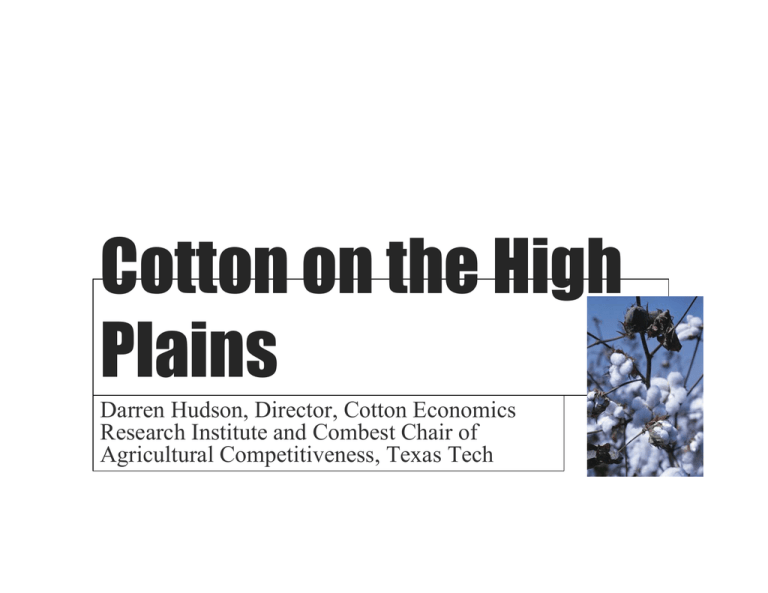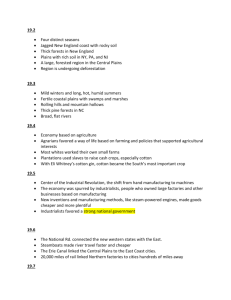Cotton on the High Plains
advertisement

Cotton on the High Plains Darren Hudson, Director, Cotton Economics Research Institute and Combest Chair of Agricultural Competitiveness, Texas Tech BACKGROUND INFORMATION The High Plains production region is ranked as the largest production region (in terms of sales) in the state and accounts for approximately 30% of the total value of agricultural production in Texas. Regional Perspective The High Plains region accounts for approximately 80% of Texas cotton production which is approximately 50% of U.S. production. Regional Cotton Production • Region sits on the largest underground aquifer in North America. • Underground water is used for supplemental irrigation (water is used to supplement rainfall). • The aquifer is exhaustible and depletion of the aquifer could have substantial impacts on regional agriculture in the future. Resource Base INDUSTRY ORGANIZATION Energy Equipment Economic Impact: ~$2.2B Export/Shipping Fiber Processing Oilseed Processing Induced Community Effects Seed and Chemicals Employment: ~6,000 Cotton Farms/Gins Induced Community Effects Employment: ~16,000 Economic Impact: ~$1.5B Supply Chain and Impacts Note: Source is IMPLAN for 2008; we have observed estimates as high as $5B total when cotton prices are high like last year. • Cooperative structure highly used • • • • Marketing cooperatives like PCCA, including processing Storage cooperatives like FCC Processing cooperatives like PYCO Many cooperative gins • “Independent” structure viable and competitive • Independent gins • Marketing pools provided by many merchants • Processors and shippers from all major companies Parallel Systems Bring Competition • Texas Tech, Texas A&M, USDA-ARS, and private companies like Smartfield, Bayer, Monsanto Yield (lbs/ac) • Research and development heavily concentrated in the area South Plains Yields Over Time. Source: USDA-NASS Innovation is the Key • Supply Side • • • • • Boll weevil eradication LEPA and then drip irrigation GPS and variable rate application systems Water management technology Varietal and genetically modified seed development • Demand Side • High volume instrument grading (reliability) • Varietal development for fiber traits • Textile developments Key Innovations • Very responsive to market demand • Moved from a lower-quality product for lower-valued end goods to a premium quality product on par with California cotton • Worked diligently to develop export market outlets • Innovators in information technology • Leaders in promoting grading technology to improve reliability of U.S. cotton to domestic and foreign users • Environment Key Regional Success Factors • Water availability/irrigation • Need continued development on drought tolerant varieties • Finding innovative policy solutions that provide maximum risk protection with less cost to the government • Keeping cotton competitive with synthetic fibers in a world with shorter stocks and higher prices • Continued R&D at the seed and textile levels to improve fiber properties and enhance consumer value • Operating in a hostile environment for trade policy Key Challenges • Cotton forms a critical economic and social backbone for the High Plains economy • Major contributor to regional employment and income • The cotton industry has been innovative in terms of productivity and consumer responsiveness • The U.S. is not the low-cost producer, but provides extreme value in quality, reliability, and timeliness Conclusions



